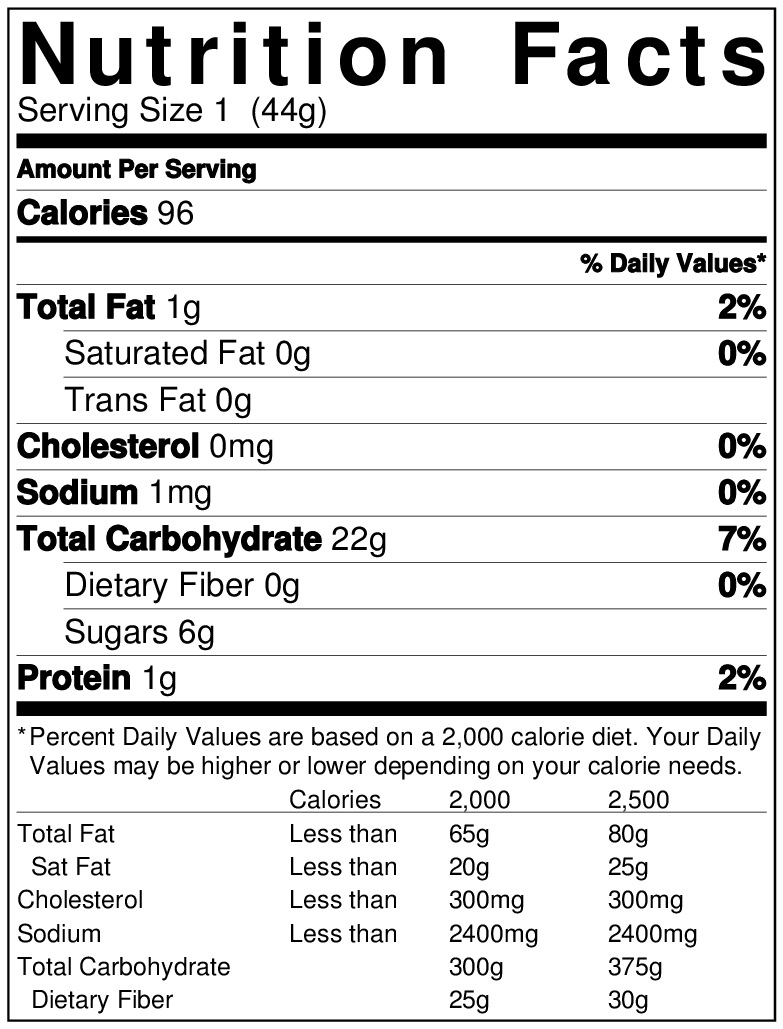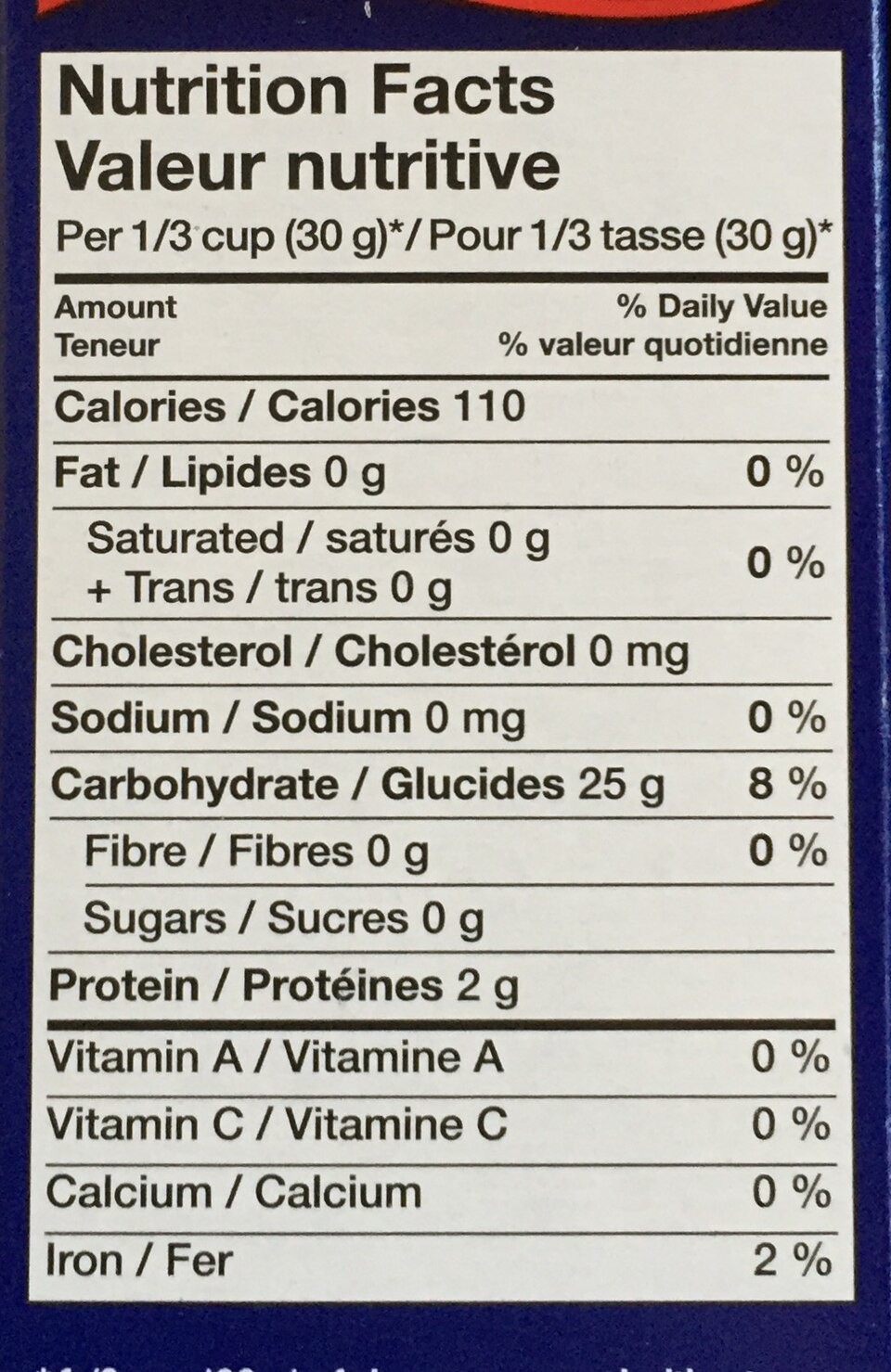9.3 Decoding Nutrition Labels
Christelle Sabatier
Learning Objectives
By the end of this section, you will be able to do the following:
- Show your understanding of the energetic value of food by decoding it from a nutrition label.
- Differentiate between the contribution of mass and calories to organismal growth.
Humans, like other animals, must consume and digest food in order to grow, maintain their tissues, and reproduce. The food that we consume comes in many different types and styles and we cannot always tell from looking at the food what specific nutrients we will obtain from it. To remedy this issue and help people make sound eating decisions, the food industry has developed a system for communicate to consumers what they can expect to ingest when they eat a specific kind of food. In the United States, this system of communication is regulated by the U.S. Food and Drug Administration (FDA) and has resulted in the specific nutrition labels that we find on many of the foods we consume (Figure 9.3.1).

Much of the nutrition label is devoted to the matter contained in the food. You can learn the total number of grams in one serving of this food (44 grams in the case of the mochi) as well as the number of grams of specific nutrients that have been deemed important to communicate by the FDA. Dietary fiber is the insoluble cellulose that cannot be digested by the human digestive tract and therefore cannot be absorbed into the body. If an individual consumes food and does not extract any energy from the matter, the individual will gain the same amount of mass as the amount from the food that it absorbs into the body.
The Calories listed on the nutrition label represent the energy contained in the food. Nutritional Calories represent the kilocalories of potential energy contained in the food. In the case of the mochi in Figure 9.3.1, one serving contains 96 kcals of energy. You can also calculate the caloric density of the food by dividing the kilocalories per serving by the serving size in grams. For example, the mochi ice cream has a caloric density of 96 kcal/44 grams = 2.2 kcal/g. Much of the macronutrients in food including carbohydrates, proteins and fat can be catabolized to transform the energy in their bonds into the energy in the bonds of ATP through the process of cellular respiration:
C6H12O6 + 6O2 → 6CO2 + 6H2O + energy (in the case of carbohydrates)
If an individual extracts all of the energy from the food that they consume, much of the matter that is associated with that food will be released back into the environment in the form of carbon dioxide and water.
In reality, the amount of mass and the amount of energy that a food might contribute to the consumer will vary depending on the activity level of the consumer. If an individual is more active after consuming and digesting the food, they are more likely to extract energy from that food. If an individual is less active after consuming and digesting the food, they are more likely to store the matter in that food in different specialized tissues in the body. Excess carbohydrates will be stored as glycogen in the liver and skeletal muscle cells. Excess fat will be stored in adipocytes. Excess protein will be stored in muscle.
Practice Questions

Glossary
dietary fiber
plant-derived substance (primarily cellulose) that cannot be broken down by the body
Figure Descriptions
Figure 9.3.1. The image depicts a nutrition facts label. It is presented in a rectangular format with bold headers and black lines separating different sections. At the top, the heading “Nutrition Facts” is in large, bold font. Below, the serving size is listed as “1 (44g)” with the total calories at “96.” The label provides a detailed breakdown of nutrients per serving, with emphasis on Total Fat, Cholesterol, Sodium, Total Carbohydrates, and Protein. Each nutrient is followed by its amount, and the corresponding percentage of daily value is listed on the right side. At the bottom, a footnote explains that the percent daily values are based on a 2,000-calorie diet, along with a detailed table listing recommended limits for various nutrients based on different calorie intakes. [Return to Figure 9.3.1]
Figure 9.3.2. The image displays a nutrition facts label on a product. The label is bordered in blue and primarily utilizes black text on a white background. It includes bilingual headers in English and French, indicating it provides nutritional data per 1/3 cup (30 g) and provides the Calories as 110. The table outlines various nutritional elements, such as fat, cholesterol, sodium, carbohydrates, and proteins, with corresponding values and percentages of daily value. Most entries state “0 g” or “0%,” except for carbohydrates at 25 g (8%) and protein at 2 g. Additionally, it lists vitamins A and C, calcium, and iron, with respective daily value percentages. [Return to Figure 9.3.2]
Media Attributions
- NutritionLabel © Jaidan899 is licensed under a CC BY (Attribution) license
- NutritionFactsValeurNutritive © Conor Alexander is licensed under a CC BY-SA (Attribution ShareAlike) license
physical substance that which occupies space and possesses mass.
Plant-derived substance that cannot be broken down by the body
Ability to do work
type of energy that has the potential to do work; stored energy
